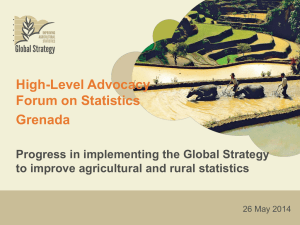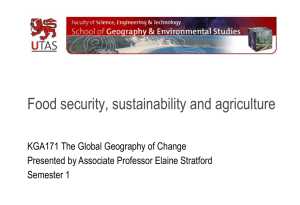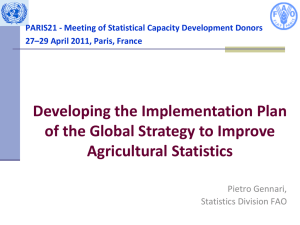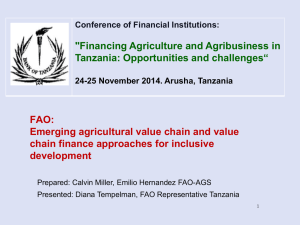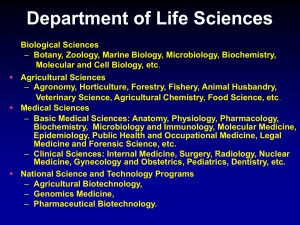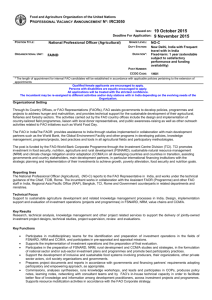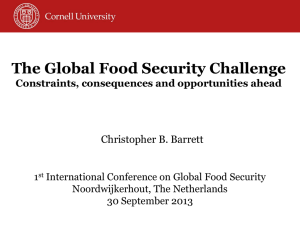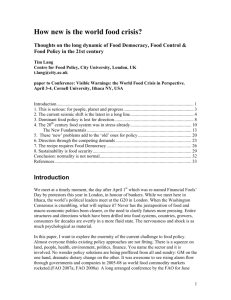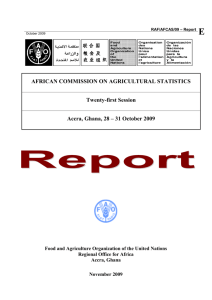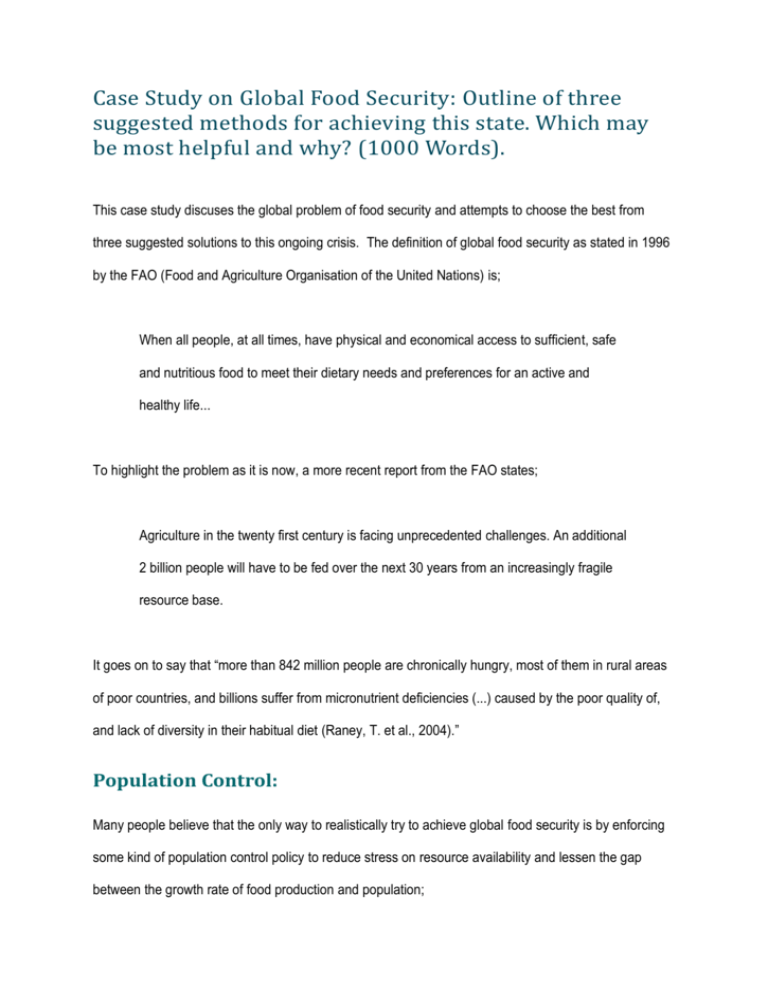
Case Study on Global Food Security: Outline of three
suggested methods for achieving this state. Which may
be most helpful and why? (1000 Words).
This case study discuses the global problem of food security and attempts to choose the best from
three suggested solutions to this ongoing crisis. The definition of global food security as stated in 1996
by the FAO (Food and Agriculture Organisation of the United Nations) is;
When all people, at all times, have physical and economical access to sufficient, safe
and nutritious food to meet their dietary needs and preferences for an active and
healthy life...
To highlight the problem as it is now, a more recent report from the FAO states;
Agriculture in the twenty first century is facing unprecedented challenges. An additional
2 billion people will have to be fed over the next 30 years from an increasingly fragile
resource base.
It goes on to say that “more than 842 million people are chronically hungry, most of them in rural areas
of poor countries, and billions suffer from micronutrient deficiencies (...) caused by the poor quality of,
and lack of diversity in their habitual diet (Raney, T. et al., 2004).”
Population Control:
Many people believe that the only way to realistically try to achieve global food security is by enforcing
some kind of population control policy to reduce stress on resource availability and lessen the gap
between the growth rate of food production and population;
Today the rate of growth of world production of basic foodstuffs – wheat, corn, soya
beans and rice – has slowed down. Since 1984, the rate of growth of world grain and
cereal production has fallen below the rate of growth of the world population, shrinking
every year by 1 percent (Brown, L., July 26th 1993, cited by De Rivero, O., 2001)
In a Malthusian-style vision of the future De Rivero says;
Unless a drastic, unprecedented fall in the birth rate occurs and is coupled with an
unprecedented rise in the supply of food, energy, water and jobs, the greater part of
the population of the underdeveloped world will live in chaotic cities and megalopolises
with millions of poor and unemployed, without adequate incomes, beset by
malnutrition, pollution and violence.
Warnock (1987) states that there has been success with birth control policies in China and Cuba, with
programs also introduced in Indonesia, Barbados, Hong Kong, Singapore and Costa Rica. These
policies usually include family planning services but are mainly incentive/disincentive based such as
those “in effect in over 30 countries” (ReVelle & ReVelle, 1992):
Incentives
Food vouchers.
Salary and pension bonuses.
Free contraception.
Medical care.
Education and future
employment for the child.
Extra vacation time for
parents.
Disincentives
Fines for going over child quota.
Rise in hospital fees.
No maternity leave for 3rd or
subsequent child.
Any international citizen wanting to
marry a Singaporean must agree to
sterilisation after their 2nd child.
Government employees in some
Indian States forfeit housing loans &
land grants if they have 3+ children.
Research has been carried out by the United Nations Population Fund that “has positively shown that a
reduction in the size of the family contributes to (...) improving education, health, nutrition and living
standards in general.” It says that countries such as Taiwan, Singapore, Chile and Argentina have the
lowest population growth rates and the fewest poor inhabitants among developing countries. This
correlation is not surprising, however this may not necessarily equate to fewer food insecure
inhabitants;
Cross-national research (...) finds population size and growth rates to be less strongly
related to hunger than other factors, and the significance of population as a driver of
hunger is very regionally specific (Harper, C. L., 2008).
Many people realise that population growth is not the immediate and main cause of global hunger. To
suggest this shows a narrow focus on the global food security problem as one of production vs.
population and tends to overlook the idea that the real problem might be one of economic access and
inequality. Under global markets food has become a commodity instead of a human right, many people
can’t afford the price and therefore have no access to it.
Sustainable Eco-Agriculture/Permaculture:
There is no disputing the fact that there is an approaching global energy crisis. Since 1981 world oil
consumption has been greater than the amount of oil being found in oil fields. This crisis will force large
changes in agricultural practice because nearly all modern farming is unsustainably dependent on fossil
fuel. For example, it takes about 10 calories of fossil fuel for each calorie of food produced via current
methods (BBC Bristol, 2008).
Environmental issues writer Richard Heinberg warns; “people have to understand that we’ve created a
way of life that’s fundamentally unsustainable and that doesn’t mean that it’s just ecologically
irresponsible, it means that it can’t continue.” This warning calls for a true ‘green’ agricultural
revolution, unlike the ‘Green Revolution’ of the 1960’s, this revolution would be directed towards
sustainability, low external input, ecologically based bio diverse food growing systems. Each country
would utilise their own natively found environments and ecosystems to produce the variety of foodstuffs
which are most naturally suited to growing there. As suggested by Kiley-Worthington (1993),
understanding the self-sustaining nature of ecosystems is crucial to developing ecologically sound
agriculture.
Permaculture uses biodiversity, the efficient growing systems and nutrient cycling of natural habitats
such as woodland, to sustainably grow a variety of nutritious foodstuffs with little external input. A
smallholding in Snowdonia is an example of this. With high levels of biodiversity every species plays
various integral roles in nutrient cycling and productivity;
Phosphate cycling by birds via their nutrient dung
Smaller birds serve as pest control by eating insects
Ducks control slug population
Bracken ‘collects’ potash and can be rotted into the soil
Worms aerate the soil and transfer nutrients
Different plant species reach nutrients at different soil depths, some deter pests and others
attract beneficial pollinating insects.
Gorse fixes nitrogen, etc.
This type of farming requires less work than conventional agriculture as most of the work is done by the
naturally occurring ecosystem; there is no weeding or ploughing. On this maximum yield design ‘forest
gardens’ such as this can feed 10 people per acre which is roughly double the amount that can be fed
from an average acre of conventional arable farmland (BBC Bristol, 2008).
Biotechnology:
This is the use of “molecular technologies such as gene manipulation and gene transfer, DNA typing
and cloning of plants and animals (FAO, 2001, cited by FAO, 2004)”
It can be used to improve many areas of agricultural production such as;
Breeding to increase and stabilise yield
Breeding to increase pest, disease, drought and cold resistance
Breeding to enhance nutritional content
Diagnosis and treatment of animal and plant diseases is also being made easier, along with nutritional
improvement in animal feed and the production of vaccines (FAO, 2004).
Agricultural development along these lines may appear improved but it often doesn’t offer a solution to
the world’s poorer farming communities;
...some biotechnology packages, particularly in the livestock and fisheries areas,
require a certain institutional and managerial environment to function properly and thus
may not be effective for resource-poor smallholders (FAO, 2004).
Also, the benefits of these ‘higher yield crops’ aren’t always getting to the local people. Instead
the foodstuffs are being exported internationally to higher paying buyers; agricultural
development has turned into a business and as such it runs with an interest on capital over the
needs and welfare of the people who depend on the produce. Productive capital all too often
doesn’t benefit the local communities from which it came (Pottier, 1999).
Crops promoted as superior and bred to have more nutritional value also need higher soil
fertility to grow. Many aren’t suitable for growing in the varying soils of the different countries
they are sold to. Expensive and polluting synthetic fertilisers are needed to make these
‘superior’ crops grow and produce high yields. This predicament has occurred in places like
Zaire which attempted to change from varied lower yielding crops to hybrid maize ‘SR-52’, the
policy was unsuccessful and costly (Pottier, 1999).
Indigenous crop species often perform better than genetically modified species in the actual
conditions of the fields (see table below).
Comparison of Productivity of Native Varieties and Borlaug Varieties of Wheat
Yield (Kg/ha)
Water demand (cm3)
Fertiliser demand (cm3)
Productivity with respect to water use (Kg/ha/cm3)
Productivity with respect to fertiliser use (Kg/ha/cm3)
Native Variety
3291
5.3
47.3
620.94
69.5
Borlaug Variety
4690
16
88.5
293.1
52.99
Source: Shiva, V. (1991) The Violence of the Green Revolution: Third World Agriculture, Ecology and Politics, p.196. Goa: The Other
India Bookstore.
Conclusion:
Localised, self-sufficient and sustainable maximum yield eco-agriculture within equality based
communities seems to me to be the most sensible way forward from the options outlined. It stands out
as the most ethical and practically sustainable option as biotechnology is still dependent on fossil fuel
and large external inputs of land, water and fertiliser, while equal food access not population growth is
more likely a cause of global food insecurity.
Eco-agriculture appears to be able to provide food for poorer people as well as everyone else.
Although having to grow crops that naturally thrive in native habitats would mean many people would
have to greatly adapt their food consumption from the current Western cereal and meat-heavy diet, to a
diet based more on nuts, fruit and vegetables.
Agricultural subsidies would have to be redirected to reward sustainable practices (Tillman, D. et al.,
2002). Shiva and Bedi (2002) state that as things are now “a large part of food subsidies go to neither
the producers nor the consumers of food, but towards subsidising the inefficiencies of external farm
input industries (...) or managing centralised procurement and distribution structure (....).” I agree with
their idea that “decentralised and democratic structures of food production and distribution” would need
to replace centralised and global initiatives so that global agri-business cannot continue disempowering
smaller scale farms and global corporations aren’t able to divert food produce away from the local
people who depend on it. Food markets, land and water rights should be much more localised to
prevent dependence on corporate imports, the destruction of domestic markets, rising food prices, and
water scarcity.
References and Bibliography
BBC Bristol (2008) Natural World: A Farm for the Future. Episode 14. [online] Available (via BBC
iPlayer) from:
<http://www.bbc.co.uk/iplayer/episode/b00hs8zp/Natural_World_20082009_A_Farm_for_the_Future/>
[Accessed: 05/03/2008]
Brown, L. (July 26th 1993) Food Output Has Stopped Keeping Up. International Herald Tribune.
De Rivero, O. (2001) The Myth of Development: The Non-Viable Economies of the 21st Century.
London: Zed Books.
FAO (2001) Glossary of biotechnology for food and agriculture: a revised and augmented edition of the
glossary of biotechnology and genetic engineering. Rome: FAO Research and Technology.
Harper, C. L. (2008) Environment and Society: Human Perspectives on Environmental Issues. 4th ed.
New Jersey: Pearson Prentice Hall.
Kiley-Worthington, M. (1993) Eco-Agriculture: Food First Farming Theory and Practice. London:
Souvenir Press Ltd.
Pottier, J. (1999) Anthropology Of Food: The Social Dynamics Of Food Security. Cambridge: Polity
Press.
Raney, T. et al. (2004) The State of Food and Agriculture 2003-04: Agricultural Biotechnology: Meeting
the needs of the poor? Rome: Food and Agricultural Organisation of the United Nations.
Shiva, V. (1991) The Violence of the Green Revolution: Third World Agriculture, Ecology and Politics.
p.196. Goa: The Other India Bookstore.
Shiva, V. & Bedi, G. (2002) Sustainable Agriculture and Food Security: The Impact of Globalisation.
London: Sage Publications Ltd.
Tillman, D. et al. (2002) Agriculture and Sustainability in Intensive Production Practices. Nature
[online]. Vol. 418. 671-677. Available from:
<http://www.nature.com/nature/journal/v418/n6898/full/nature01014.html> [Accessed: 22/03/2009].
Warnock, J. W. (1987) The Politics of Hunger. London: Methuen & Co Ltd.


